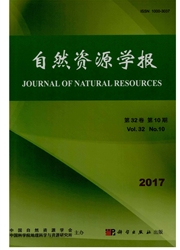

 中文摘要:
中文摘要:
采用罗伦兹曲线、重心模型等GIS技术,利用1980 s和2000年两期覆盖全国跨度10多年的土地利用数据,构造耕地指数、耕地变化指数对中国耕地空间分布及其空间变化格局进行分析。主要结论:①中国耕地主要分布在黑、川、蒙、豫、鲁等北部和中部省份,其中苏、粤、冀、鲁、浙等19个省份的耕地有所减少,黑、蒙、吉、新等13个省份的耕地有所增加;②胡焕庸线之东南40%的国土面积分布着全国88%的耕地;西北60%的国土面积分布着全国12%的耕地,中国耕地空间分布可划分为高度稀疏区、低度稀疏区、一般过渡区、低度集聚、高度集聚区等5种类型;③中国耕地变化区域类型可适度划分为高度增长区、中度增长区、低度增长区、基本不变区、低度减少区、中度减少区、高度减少区等7大类型。顾及耕地质量背景下的中国耕地空间分布格局及变化特征等应进一步研究。
 英文摘要:
英文摘要:
As industrialization and urbanization accelerates,the contradiction between limited cultivated land resources and the expansion of construction land and ecological land is becoming increasingly acute.By Lawrence curve,models of gravity center and level classification division and other spatial analysis technique,this essay conducts an in-depth study of the spatial distribution pattern of the total cultivated land changes in China based on the national land use data between the 1980s and 2000.The main conclusions are as follows: Firstly,the total cultivated land increased 28374 km2 during the past ten years,with an increase of 25328 km2 in dryland,accounting for 89.26%,and 3046 km2 in paddy,accounting for 10.74%.Secondly,China’s cultivated land was mainly distributed in Heilongjiang,Sichuan,Inner Mongolia,Henan,Shandong and other northern and central provinces.The total cultivated land had reduced in 19 provinces including Jiangsu,Guangdong,Hebei,Shandong and Zhejiang,etc.While the rest of 13 provinces such as Heilongjiang,Inner Mongolia,Jilin,Xinjiang,etc saw an increase in the total cultivated land.Thirdly,we found that 88% of the nation’s cultivated land was distributed in the southeast of Hu Huanyong’s line,occupying 40% of land area by measurement of cultivated land indices.The spatial distribution pattern of China’s cultivated land could be appropriately classified as high degree of sparse areas,low degree of sparse areas,general transition zone,low concentrated areas and high concentrated areas.Fourthly,the types of China’s cultivated land changes could be considered as such seven major types: high growth areas,moderate growth areas,low-growth areas,general transition area,low degree reduction area,moderate degree reduction area and high degree reduction area guided by cultivated land changes index and gravity centers curve of cultivated land changes.This paper aims to reveal the spatial distribution pattern and changes of China’s cultivated land by applying the spatial analysis methods.It p
 同期刊论文项目
同期刊论文项目
 同项目期刊论文
同项目期刊论文
 Comprehensive Assessment and Promotion Policy of Producer Services’ Competitiveness in Beijing City:
Comprehensive Assessment and Promotion Policy of Producer Services’ Competitiveness in Beijing City: Measurement and spatio-temporal distribution of urbanization development quality of urban agglomerat
Measurement and spatio-temporal distribution of urbanization development quality of urban agglomerat Comprehensive Measurement for Carrying Capacity of Resources and Environment of City Clusters in Cen
Comprehensive Measurement for Carrying Capacity of Resources and Environment of City Clusters in Cen Resource-environment Bases, Evolution and Dynamic Forces of Urban Agglomeration Development on Yangt
Resource-environment Bases, Evolution and Dynamic Forces of Urban Agglomeration Development on Yangt Input-output Efficiency of Urban Agglomeration in China: An Application of Data Envelopment Analysis
Input-output Efficiency of Urban Agglomeration in China: An Application of Data Envelopment Analysis Comprehensive Delimitation and Ring Identification on Urban Spatial Radiation of Regional Central Ci
Comprehensive Delimitation and Ring Identification on Urban Spatial Radiation of Regional Central Ci 期刊信息
期刊信息
